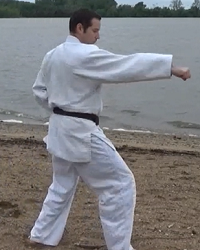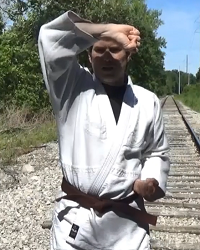
Age Uke
Age uke, or the 'rising block', is used to defend against an overhand attack to the head or deflect an attack so that it is redirected above the head.
Continue reading
Oi Tsuki - Lunging Punch
The lunging punch combines the energy of forward motion with the speed of your punch to deliver a powerful strike!
What is "Oi Tsuki"?
Tsuki, meaning "thrust", "jab", or "stab", coming from the verb tsuku, is used to describe many punching techniques. Techniques using tsuki (often also seen as 'zuki due to the way that it's pronounced) will always follow this type of motion. It is important to note that, while tsuki is a type of punch, it does not mean "to punch". In fact, there are two types of punches: tsuki, which we're discussing in this article, and uchi which means "strike" (think knife-hand strike or elbow strike).
Oi is a lunging or "hunting" motion. Oi komi or oi sagari, for example, are both movement strategies that employ quick short movments forward to press an opponent backward or close the distance to meet an advancing opponent. Oi tsuki, then, is a thrusting or jabbing punch from a lunging or forward moving position and is always performed by the lead hand.
How to Execute Oi Tsuki
Technique Basics
The oi tsuki uses the first two knukles from the thumb, also referred to as seiken. For the kihon of this technique, start in a nuetral stance (yoi dachi or heiko dachi) with both hands in a chambered position at the waist. Step one foot forward into zenkutsu dachi. As you step, the hand on the same side as the stepping leg moves forward with palm facing up. Move the hand toward your centerline (either chudan or jodan as the target area); keep your wrist straight as the fist travels toward the target. At about 2 inches from the target begin rotating your wrist so that the first two knuckles impact at 90°. Your elbow should still be bent at the point of impact. Continue the punch into the target and complete the rotation so that the palm is now facing down (180° from the chamber position).
With any tsuki there are a few key items to pay attention to as you practice.
First, be careful that you do not hyperextend your punch. This is especially important if you are practicing without a target to impact. Do not overextend your elbow either by straightening all the way; leave the elbow slightly to avoid injury.
Second, as with any technique, take the time to drill slowly and pay attention to the details. As you master the minutiae you can begin to focus on speed and power.
Finally, do not leave the arm extended after the punch is thrown. You should immediately return to your chamber position, a defensive posture, or proceed to your next technique. In an actual fight, leaving your arm extended is a good way to get it broken.
Oi Tsuki from Oi Komi
Oi komi, a way of moving forward while striking, moves the front leg forward first and the back leg slightly behind in a shallow or dragging motion. This movement is excellent to combine oi tsuki with as you are already moving forward and your hands will most likely already be in a defensive or 'gaurd' position. The variation on the punch will be that instead of having a full wrist rotation you will probably only have a quarter rotation.
This combination closes the distance to your attacker when they are slightly out of your arm's reach and you don't want to use a kicking technique. Not only does it close the distance, but it adds the momentum of your lunge to the punch which increases its power.
Stepping forward into Oi Tsuki
There will be times when a shallow lunge will not close enough distance and you need to take a complete step. This technique is usually a little slower than using oi komi but it is significantly more powerful as it has the full force of your body moving behind it and give you time to set up for a full wrist rotation.
To practice this technique, start in zenkutsu dachi with one the rear hand chambered. Step so that the rear leg is now the lead leg and you are still in zenkutsu dachi. As you step, just as you did for the basic kihon, move the hand forward with the palm facing up until just before the point of impact on the target.
Tips and Variations
Keeping the hands in a chambered position are great for traditional training and katas, but when fighting or working with a punching bag keep the hands in a guard position and roll the shoulder when executing the punch to protect the neck and jaw.
This punch uses several muscles to be effective.
Use the following stretches before drilling this technique:
- Tricep stretch
- Forearm extensor stretch
- Chess compressions
- Large shoulder circles
- Small shoulder circles
- Hamstring stretch
- Quads stretch
The following poses are useful to stretch the muscles needed for oi tsuki:
- Downward dog
- Hero
- Reclining hero
- Pigeon
- Boat
- Warrior I
- Warrior II
- Crow pose
- Headstand
There are many workouts that are useful for improving your tsuki punches. The following are just a few:
- Push-ups
- Planks
- Burpees
- Shoulder taps
- Mountain climbers
- Pull-ups